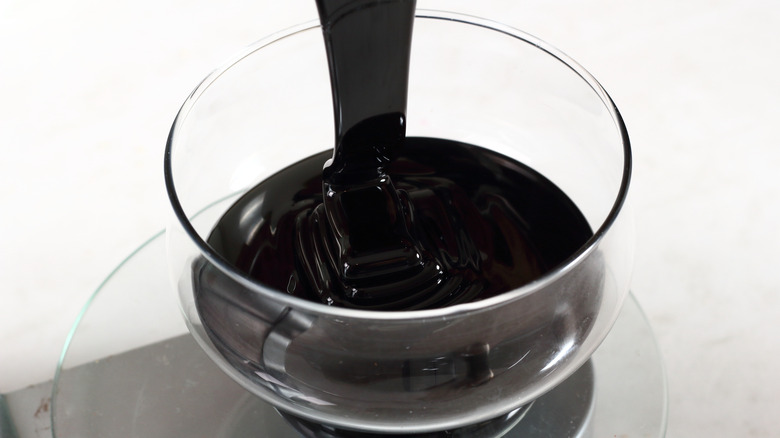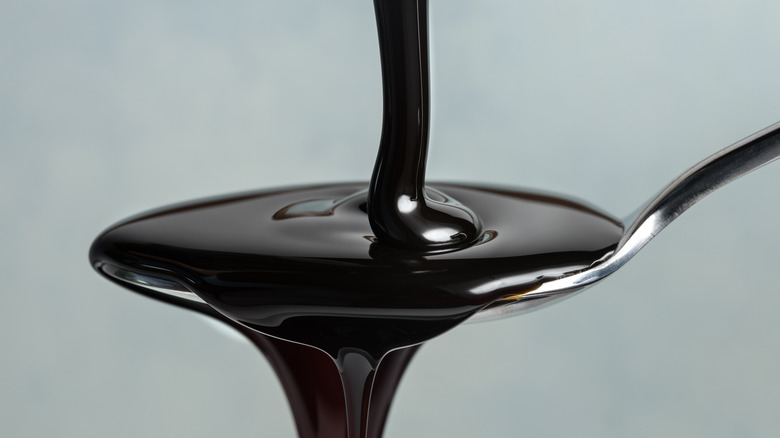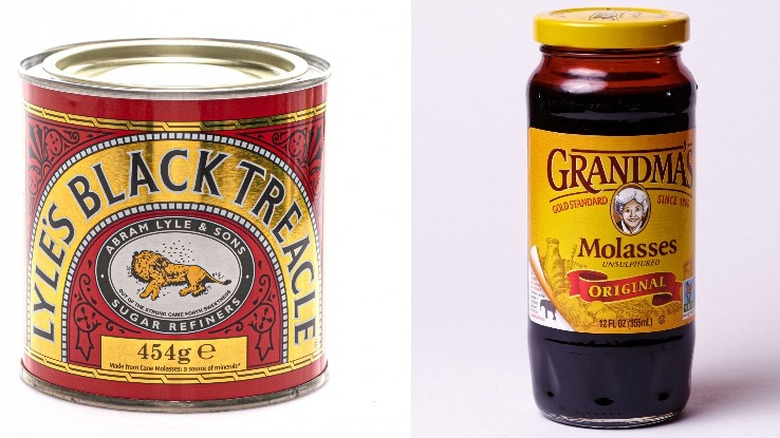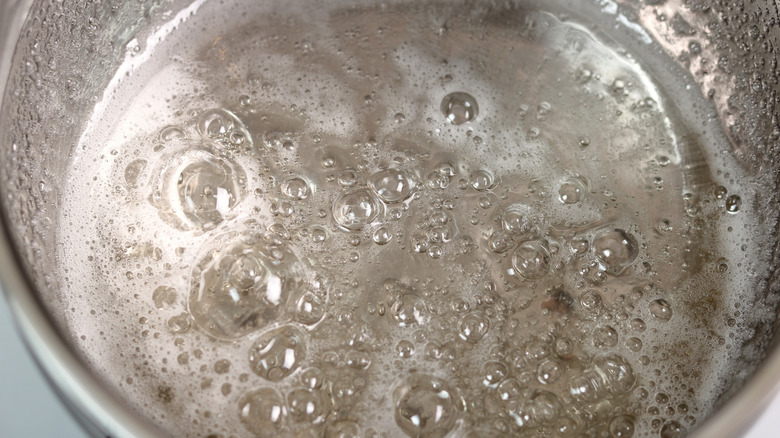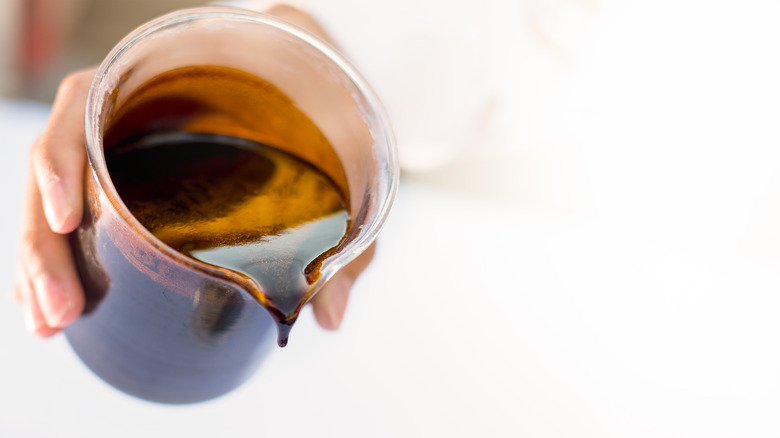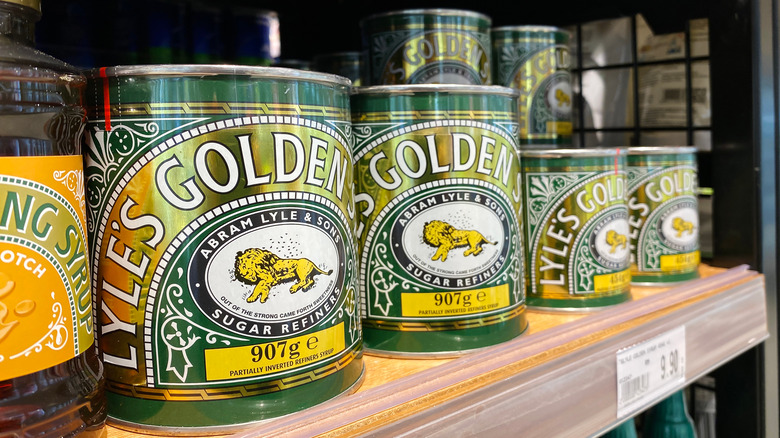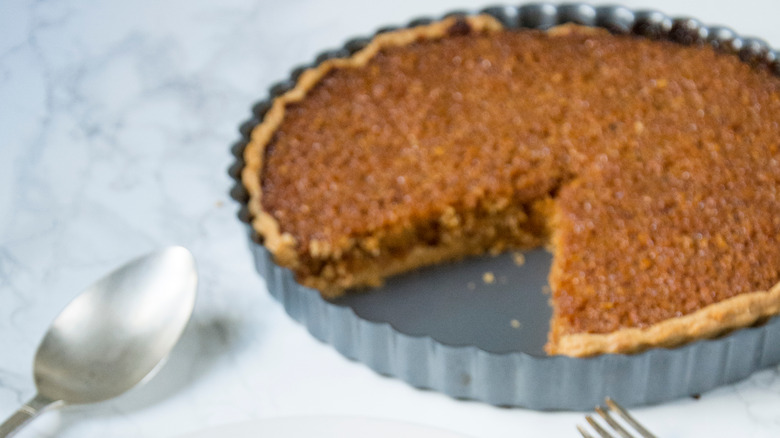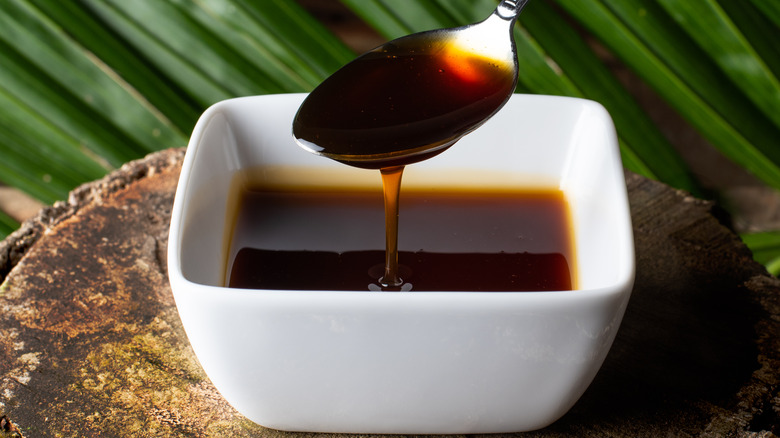What Is Treacle And What Does It Taste Like?
We may receive a commission on purchases made from links.
If you live outside of the U.K., you probably only recognize the word treacle thanks to British pop culture. Perhaps you recall that Harry Potter's favorite dessert is a scrumptious treacle tart, which also happens to be the same treat that the kids in the 1960s film "Chitty Chitty Bang Bang" gleefully squeal about (via YouTube). Maybe you know the word because it's in the title of the Arctic Monkeys' single "Black Treacle" or because it's been mentioned on "Great British Bake-Off." If Mary Berry is a fan (via the BBC), surely it must be good stuff!
To put it plainly, treacle is the thick, goopy syrup that's left behind after raw sugar cane juice is refined to make regular white sugar (via The Times). Known for its intense sweetness and rich caramel flavor, treacle is considered a staple ingredient in many countries. It can be found in both sweet and savory dishes around the world. Lyle's, one of the most well-known treacle manufacturers, has been around for more than 100 years and reportedly ships out more than 1 million tins of treacle every month (via the Lyle's Golden Syrup website).
But what is it about this syrup that's so special? And is it really just molasses with a fancy name? We're here to answer those questions for you.
Treacle was originally used as a form of medicine
Though treacle is considered to be a beloved kitchen staple today, it wasn't always regarded as such, says Cooks Info. During the Victorian era, treacle was sold out of barrels to sugar refinery employees and thus was a cheap product that initially had little value as food for the general public (via British Food History). It didn't start to gain mainstream appeal until the late 19th century when people started adding it to desserts like gingerbread and noticed that it lent the treats a complex flavor that other sweeteners like honey and licorice could not.
Prior to that, treacle was something people more commonly ate for health reasons. They believed that treacle could improve blood flow, so it was commonly found in the recipes for poison antidotes. They weren't that far off in their belief because blackstrap molasses (which is similar to dark treacle) is said to lower blood pressure due to its high potassium content.
Even though treacle later became known as a kitchen staple, the practice of using it for medicinal purposes continued well into the 20th century. According to BBC contributor Bet Vaughan Williams, in the 1930s, when diseases like polio and tuberculosis were a looming threat to people around the globe, people in Wales reportedly fed their children a mixture of treacle and sulfur to keep their blood clean. Perhaps the saying should have been "A spoonful of treacle helps the medicine go down."
Treacle vs. molasses
Given the comparisons to molasses, you'd probably assume that treacle tastes just like it. In fact, The Spruce Eats classifies black treacle as a syrup that falls under the molasses umbrella. However, while these two uncrystallized sugar syrups share a lot in common, they actually have different flavor profiles and uses. As Ragus notes, molasses is stronger and more bitter than treacle, which is why it appears in savory-sweet recipes like BBQ sauce or meat marinades. Treacle, on the other hand, boasts more of a caramel flavor that's better suited for desserts like fruit cakes and cookies.
Ragus states that black treacle can stand in for molasses in recipes because it's technically made up of a mix of molasses and refiner's syrup. By contrast, Spiceography insists while dark molasses can be used in place of black treacle, using blackstrap molasses in place of black treacle will ruin a perfectly good dessert. Overall, it seems the general rule of thumb when making substitutions is that golden syrup (light treacle) goes with light molasses, while dark treacle goes with dark molasses. And even then, depending on the recipe, this rule doesn't always apply, so experiment before serving to a crowd. As one reviewer of Tate & Lyle's black treacle on Amazon advised, "If a recipe calls for treacle, use treacle." However, if a recipe calls for light treacle and you don't have any, using light molasses as a replacement should be fine, says Spiceography.
How does treacle get made?
Depending on who you ask, "treacle" refers to a few different things. For some people in the U.K., treacle means all types of uncrystallized liquid sugar sweeteners (via Spiceography), which can be confusing since they all have very different uses and flavors. As a Reddit thread discusses, others use the term "treacle" as a shorthand for black treacle, which is the most bitter of those sweeteners, while referring to light treacle as "golden syrup." To add to the confusion, some people often use the term interchangeably with molasses (via BBC Good Food and The Spruce Eats). And the thing is, none of these definitions are wrong. But they aren't exactly 100% correct either.
Per the Martha Stewart website, treacle is manufactured at a range of intensity levels, but the most well-known kinds are light treacle (also known as golden syrup) and black treacle. Both syrups are the byproducts of boiling and extracting sugar crystals from raw sugar cane juice, but they're removed from the process at different stages, which in turn gives them their respective colors and tastes.
What does treacle taste like?
Light treacle is pulled early in the boiling process, so it retains more sugar molecules than the darker treacles produced through longer refinement. It is, therefore, not only the lightest but also the sweetest variety of treacle. The famous light treacle Lyle's Golden Syrup is described as having a yummy butterscotch flavor (via British Food History). According to a user on the Quora forum, "golden syrup is a bit like a very thick viscous honey almost chewy in texture and very sweet with a hint of caramel" but warns that after a few spoonfuls what was once a "divinely sweet" experience "will induce nausea."
The more the syrup goes through this refinement process, the darker and more concentrated its flavor becomes. As a result, dark treacle and black treacle are said to be richer with notes of burnt caramel. Some even describe their tastes as smoky or, according to The Guardian, "metallic." The aforementioned Quora user likened black treacle to an "almost savory molasses," noting that it had a similar texture "but a burnt, slightly acrid taste."
Where to buy and store treacle
For U.S. customers, online is the best option if you want the real stuff. You'll recognize Tate & Lyle's brand black treacle since it comes in distinct red and yellow tins. As far as cost goes, a single 16-ounce container of treacle costs just under $10 (via Amazon). Though that may sound like a lot for syrup, know that a little goes a long way with this stuff because of how intense the flavor is. A 16-ounce tin of Lye's Golden Syrup (light treacle) comes in green and gold packaging and can also be found on the Amazon website for under $10.
Once purchased, keep your treacle tin in a dark, dry place, like the back of a cupboard, and it should last up to a year (The Spruce Eats). Do not heat it under any circumstances. When you're ready to use your treacle, simply open the tin, dip a spoon in, and scoop out as much as you want. Wipe down the lid after each use to prevent it from sticking like glue to the sides of the container. Though treacle doesn't require refrigeration, be mindful of the expiration date on the tin. Per Lyle's official website, once you open golden syrup, it's best to consume it within three months.
What to cook with treacle
Due to its highly concentrated caramel flavor and thick, syrupy consistency, treacle makes an excellent addition to many dessert recipes. Additionally, BBC Good Food notes that for vegans, treacle works as a great bee-free substitute for honey. As a result, home cooks and professional bakers alike love adding treacle to sweets like toffees, gingerbreads, fudges, puddings, cookies, and cakes, as well as savory foods like marinades. There are also some cocktails and beer that feature treacle as a sweetener. As one home cook put it in HowStuffWorks, "I only use [treacle] once a year, but it adds sumptuousness to the cake that no other ingredient can give."
Need some inspiration for what to use your treacle for? Try getting started with some old-fashioned British treats. Dinah Bucholz's "The Unofficial Harry Potter Cookbook" offers a recipe for a 9-inch version of treacle tart (via Epicurious) paired with a creamy custard and whipped cream. Looking for something better suited for the summertime? Drizzle a spoonful of treacle over ice vanilla cream for a burst of caramel sweetness. As far as black treacle goes, don't fall into the trap of thinking it's only good for Christmas fruitcake. Treacle can be used to complement the flavors of meats and fish in savory dishes, too. The Guardian shares popular recipes like black-treacle marinated shrimp, black-treacle sweetened baked beans, and dumplings.
One thing to keep in mind: Because treacle is ultra-rich and potent, a little bit goes a long way. If you're not used to it, try adding just a few tablespoons to your desserts before going all-in with it.
Is treacle nutritious?
Not to rain on anyone's parade, but since treacle is pretty much made of super-concentrated sugar byproduct, it's generally recommended to limit your intake of it, especially if you're at risk for diabetes or other health conditions (via National Health Service). Moreover, Spiceography points out that sometimes black treacle is treated with sulfur dioxide to extend its shelf life. Some people should be wary of that fact. Per a study by the British Journal of Diseases of the Chest (via National Library of Medicine), people in good health are fine to eat small quantities of sulfur dioxide, but those who suffer from conditions like asthma may want to avoid it since it can trigger symptoms.
However, that doesn't mean treacle is all bad for you. As Ragus points out, like molasses, black treacle has a high mineral content which makes it a notable source of iron, calcium, potassium, and magnesium. The United Kingdom National Health Service even lists black treacle as a viable meatless source of iron, with 3.2 milligrams per 15-gram portion. Fun fact, it was once used by sailors to treat scurvy (via Cooks Info). But again, it's generally not a good idea to gobble up spoonfuls of it (and we're not sure if you'd want to, either, given its super-strong taste) every day with the intent of getting your daily dose of nutrients. Truth be told, you'd probably end up with a stomach ache before getting the daily mineral requirement, anyway. But a spoonful here and there won't hurt.
